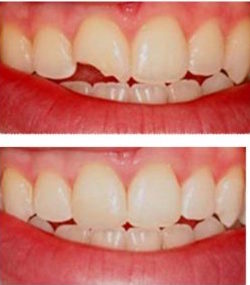RESTORATIVE DENTISTRY
Beautiful Smile
We work passionately toward creating the most youthful smiles for patients whose natural teeth require replacement.
If your teeth are damaged in a way that makes it impossible to reconstruct them with fillings or you are missing one or more teeth, we can return the smile to your face as well as a strong bite and speaking ability with the use of advanced prosthetics.
We are proud of the ways in which dentistry can restore broken or decayed teeth to full beauty and function. One of the easiest and least expensive ways of doing this is with dental bonding.
Bonding uses tooth-colored materials to replace missing tooth structure or hide cosmetically unappealing minor defects in a tooth — chips, discoloration, and even minor spacing irregularities. Bonding materials are called “composite resins” because they contain a mixture of plastic and glass, which adds strength and translucency. The composite actually bonds, or becomes one, with the rest of the tooth.
Composite resins come in a variety of tooth shades for truly lifelike results. When bonding is done with a skilled hand and an artistic eye, it may be impossible to distinguish the bonded tooth from its neighbors. Though bonding will not last as long as a dental veneer, it also does not require the involvement of a dental laboratory and, most often, can be done without drilling of the tooth. It's a particularly good solution for teens, who often need to wait until their teeth have finished maturing before choosing a more permanent type of dental restoration.
The Bonding Process
Because it does not involve dental laboratory work, tooth bonding can usually be accomplished in a single visit to the dental office. Expect the whole procedure to take 30 minutes to an hour. First, the surface of the tooth to be bonded will be cleaned so it is plaque-free. The surface will then need to be “etched” with an acidic gel that opens up tiny pores in the surface. After the etching gel is rinsed off, the liquid composite resin in a well-matched shade is painted on in a thin layer, filling these tiny pores to create a strong micromechanical bond. A special curing light is used to harden this bonding material. Once the first layer is cured, another layer is painted on and cured. Layers can continue to be built up until the restoration has the necessary thickness. The bonding material is then shaped using a dental drill to give it just the right form. Once the tooth not only looks great but fits in perfectly with your bite, it will receive a final polishing.
Caring for Bonded Teeth
Bonded teeth should be brushed and flossed daily, and professionally cleaned at the dental office twice per year, just the same as the rest of your teeth. The most important thing to keep in mind about caring for your bonded tooth is that composite resin can absorb stain, just as natural teeth can. Therefore, you will want to avoid smoking, red wine, coffee and tea to the extent possible. Also, while composite can darken, it cannot be lightened. So if you are thinking about having your teeth whitened, it should be done before your tooth is bonded so that a composite shade can be selected to match the lighter color of your whitened teeth. If you whiten your teeth after bonding, the bonded tooth may not match all the rest. Finally, try not to bite your nails, hold writing implements in your mouth, or use your teeth in other ways that could put excessive force on the bonding material and chip it. With proper care, a bonded tooth should stay beautiful for 3 to 10 years.
If your metal fillings are old, now may be the perfect time to swap them for tooth-colored composite ones. Leakage. Amalgam fillings are not bonded to tooth structure, so overtime saliva, food, bacteria can creep down the margin of the filing into the tooth and set up tooth decay.
REASONS TO REPLACE AMALGAM FILLINGS
If you are thinking about replacing metal fillings, here are typical reasons to update them:
- Fracture Teeth. I see so many teeth that have amalgam fillings, with cracks all around their teeth. Even small conservative amalgam fillings done on pre-molar teeth can lead to their fracture. Why? when dentist remove the cavity and prepare the tooth for an amalgam filling, a predetermined amount of tooth structure must be "sacrificed" - removed - so there is adequate bulk of amalgam to resist breakage. The net result is more tooth structure is lost and the tooth becomes weaker. With composite fillings, we dentists can be conservative and we are "bonding" to the tooth - so it becomes stronger.
- Age. All fillings get old and at some point need to be replaced. Loose fillings allow bacteria to invade a tooth and introduce new decay. If your metal fillings are old, now may be the perfect time to swap them for tooth-colored composite ones.
- Leakage. Amalgam fillings are not bonded to tooth structure, so overtime saliva, food, bacteria can creep down the margin of the filing into the tooth and set up tooth decay.
- Cosmetic Reasons. Metal fillings were designed for function, not beauty. But in our telegenic world, many people believe an attractive smile is an important benefit that tooth-colored fillings provide.
A MAJOR CONSIDERATION
There’s one more consideration before you remove your fillings. The Food and Drug Administration (FDA) does not support removing metal fillings until they become old and start to fail because the extra dental work to remove them prematurely can cause more harm than good.
Also, be prepared for sensitivity for 2 weeks if you have them replaced. I think for esthetically driven patients removal is a good option, but any time a tooth is drilled on it may be sensitive, and unfortunately it is normal.
As noted above, if you are considering having metal fillings replaced, you should request a personal consultation with a dentist to discuss the pros and cons. Dr. Damon can assess your tooth, explain when it would be appropriate to remove the old filling, and discuss what type of filling would be suitable.
BENEFITS OF COMPOSITE FILLINGS
A prime consideration for many patients is appearance. Restorations with composites create a tooth-colored repair that blends in with other teeth, avoiding the harsh and unattractive appearance of metal.
But composites have other advantages as well. In addition to looking natural and visually blending in with other teeth, composites:
- Do not contain mercury.
- Bond to the tooth and strengthen it.
- Require less of the tooth to be removed to place the filling.
With so many advantages, you may be weighing the benefits of swapping out your metal fillings for this more attractive option.






Dental Implants
Replacing Missing TeethDentures
Returning Your SmileDental Crowns
Saving Natural TeethPorcelain Veneers
Perfecting Your SmileOral Health Consultation
Includes Full Mouth X-Ray and Treatment Plan
Exam & Cleaning
Includes Full Mouth Cleaning
White Filling
Includes 1 Composite Filling
Full Mouth Digital X-Ray
Minimally Invasive Techology
PAYMENT OPTIONS
For your convenience we accept:
Cash or Checks -Debit Cards – MasterCard & Visa ,American Express, Discover
Payment options are: “ “Spring Stone patient financing ,Care Credit”, and etc. We believe our patients should have access to the best treatment options possible regardless of their type of payment.
INSURANCE
We accept most of Insurance plans including all PPOs, DHMO plans,
Denti-cal .
REQUEST AN APPOINTMENT
Fill out the form and we will contact you during our working hours. Urgent dental care will be provided usually the same day.
SPECIAL OFFER
10% Off Dental Implants
-
Permanent solution for replacing missing teeth
-
Natural function and appearance
-
Improved chewing and speaking abilities

